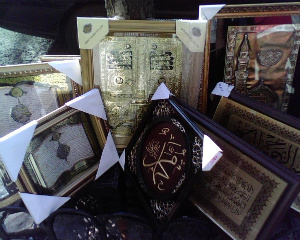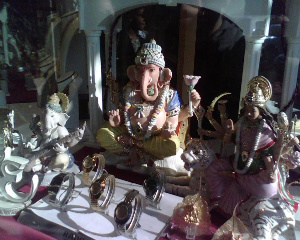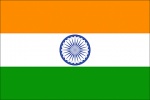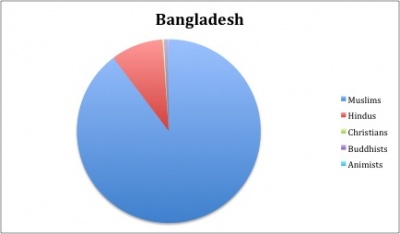From The Peopling of New York City
The culture of Jackson Heights is a varied one to say the least. It is a melting pot of cultures in a land that they are all foreign to. Not only is the neighborhood filled with various South Asian cultures, but it is also occupied by Hispanic and Asian peoples. Hybrid Asian and Indian cuisine restaurants can be found alongside purely India food establishments. How is this constant exposure to these other cultures affecting the neighborhood and its numerous cultures and people?
Underlying Tension in Jackson Heights
Indians, Pakistanis, Bengalis, and Nepalis. Muslims, Hindus, and Buddhists. Different cultures with completely different religions comprise the population of Jackson Heights. These people call this area home but also like to come to the area to shop and eat. But when all these different cultures come together in the same area one must wonder, do they get along? In our research we have discovered that to our surprise these cultures get along without any real confrontation.
So one must wonder why can these cultures exist in such close proximity without any violence erupting? Maybe the reason is due to the fact that these people live so close that out of necessity they must not cause any problems. Also these cultures are all from the same area of the world so their cultures are very similar in many aspects. Perhaps as these similar cultures were bought together in the same area they began to realize that they had more in common with each than they had expected. The area around the South Asian part of Jackson Heights is surrounded by people of many different nationalities including many Hispanics. The South Asians would form a community to surround themselves with people of similar cultures. Also back in their native country, religion is extremely important and it is the main reason for the cultural tension. In the United States the idea of religion has become virtually insignificant. People put less of an emphasis on religion, so this may explain why little or no issues exist.
Just because tension cannot be seen in the form of violence doesn’t entirely mean that people do not have prejudices against the different cultures. In one interview we learned that “in businesses, some people have difficulty getting jobs due to differences in religion and heritage.” So people may have their biases, but they choose to not reveal them. However, in many interviews it was revealed that some people do not really like the Bengalis who seem to be taking over Jackson Heights, both in population and in the business world.
Also in our research we found one source of tension when a mixed Hindu-Muslim family decided to cremate their son in the Hindu tradition. The public found out about their choice after two Muslim acquaintances protested the family’s choice. The family accused the protesters of trying to create a boycott of a shopping mall that they owned, and the police hate crimes unit was called. This is just one example of tension, but other than that we were unable to find any other source of hatred. This just shows that these different yet similar cultures have been able to come together in such a small area without much animosity. They have been able to ignore their differences in religion and see the commonality between them.
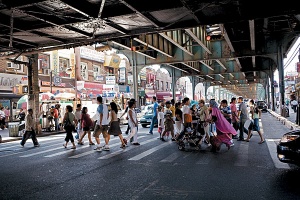
An Outsider's Point of View of Jackson Heights
Jackson Heights is a neighborhood full of various South Asian cultures such as the different peoples of North and South India among other cultures such as Hispanics and Asians. Being a South Asian youth and growing up with the experience of being in Jackson Heights on a regular basis can drastically change how the Youth interact. In an interview with a South Asian teenager, the responses of a young South Asian girl that did not grow up in or being around Jackson heights constantly show the discrepancies between her life as an Indian teenager as opposed to other youth. Her responses, compared to those of others such as Kanushree Jain show the differences between teens that were raised in Jackson Heights and other South Asian neighborhoods rather than in other suburbs.
The interview with the Indian girl from Staten Island shows that, as an outsider, she does not identify as much with her Indian heritage as other South Asian teenagers do; only speaking her native language at home with family as opposed to other South Asian teenagers. Another example of an outsider's view of Jackson Heights as a South Asian community is the interview with Reema Prakash who only recently moved to the United States a few years ago. The trend seems to be that the less exposure to their respective culture’s that they receive on a daily basis, the less likely they are to become ethnocentric.
Multicultural Similarities
Though the ethnic landscape of Jackson Heights differs from the majority of the New York City population, they both share many similarities. For example, in New York City, numerous business owners hire Hispanic immigrants to work in their stores because they are a source of cheap labor for the store owner. In Jackson Heights, the trend is to higher “co-ethnics” to work in stores because they are more loyal and they tend to speak the same language and if they don’t they are generally familiar with the culture of the region. This similarity in language also provides South Asian customers with a certain level of comfort since many of them visiting said shop will speak the same language as well. While this is the trend, Hispanic workers can be found in some stores in Jackson Heights such as food establishments. Maybe this shift in the kind of workers being hired at certain establishments in Jackson Heights shows that it is slowly becoming more like the surrounding city and absorbing some its qualities rather than staying completely South Asian. The fact that Hispanic workers are being acquired by stores also reflects the reality of the growing population of Hispanics in the neighborhood. Jackson Heights is becoming more multicultural than it already is with the addition of Asian and Hispanic cultures alongside the already existing South Asian cultures.
This chart below is based on the census data of New York City from the year 2000 census. The chart shows the percentages of the total South Asian population and what boroughs they live in. The South Asians represented in this chart consist of all the peoples of South Asia such as Indians, Pakistanis, Nepalis, Bangladeshis and Tibetans. According to it, a large majority of South Asians live in Queens, and although it is not specified on the website, a majority of those cluster around South Asian communities such as Jackson Heights.
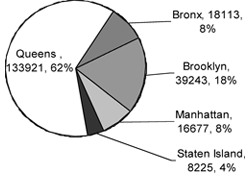
Interviews Used
Lue Interview with a South Asian Youth
Predominant Religions of South Asian Countries
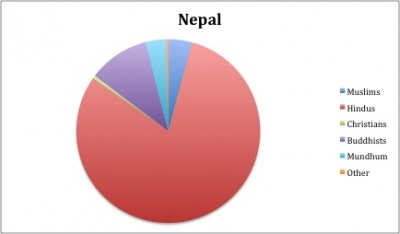
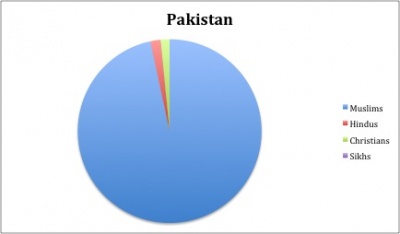
This page was done by Mina Aziz and Gavin Lue

